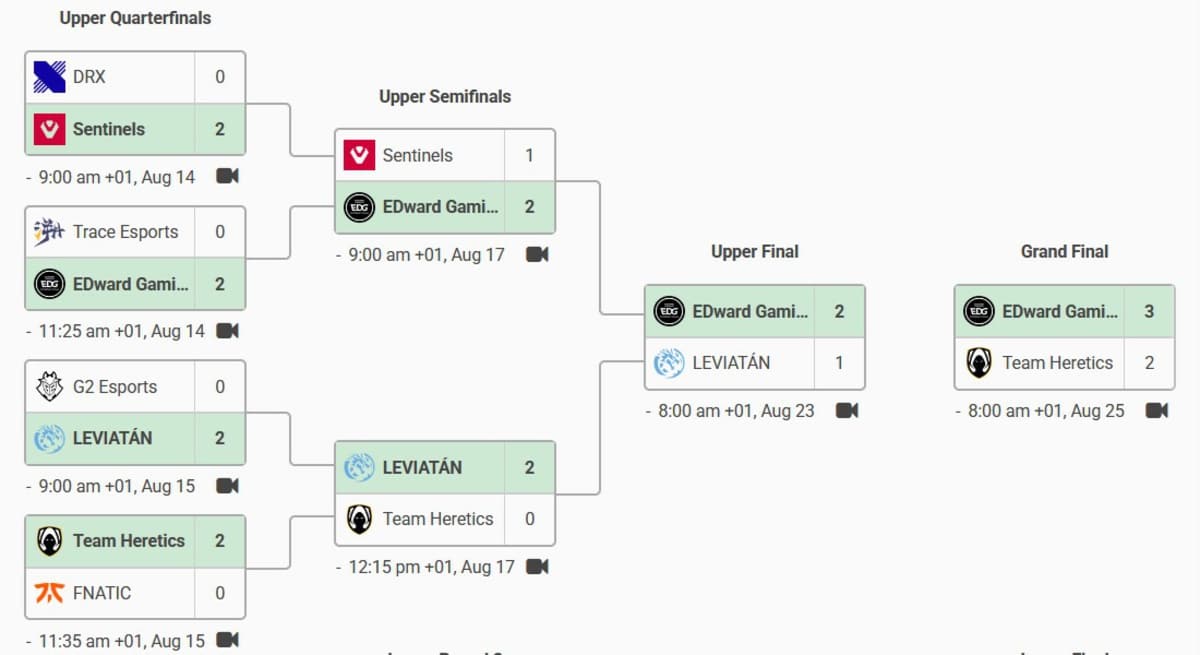Valorant is a tactical shooter game developed by Riot Games. It has a very organized competitive scene with a structured bracket and rank system. But for those new to the game or who want to learn more about how a Valorant bracket works and how to move through the game’s ranks, we break down everything you need to know in this concise and easily understood guide.
What is a Valorant bracket?
In Valorant esports, a “bracket” is the tournament format that pits various teams against one another. The most popular format is the double-elimination bracket, with a team having to lose twice to be out. This format is used in major Valorant tournaments like the VALORANT Champions Tour (VCT).
VALORANT Champions Tour 2025 Bracket Format
The 2025 VCT Kickoff events are all double-elimination brackets that feature 12 teams from each region. The top 4 teams from the previous year’s standings get a bye in the first round, i.e., they do not play in the first round and start playing from the second round. The top 4 teams in each Kickoff receive Championship Points, which are essential to qualify for larger events like Masters and Champions. The winner of the kickoff earns 3 points, and that is a pretty good step ahead in the whole season.
Under the double-elimination format, teams start in the upper bracket and are dropped into the lower bracket if they lose a match. A second defeat eliminates that team from the tournament. The tournament’s format provides teams with a second opportunity, thereby intensifying the competition.

Understanding Valorant’s Competitive Ranking System
Players with similar skill levels can compete against each other and track their progress through Valorant’s ranking system. There are 25 ranks divided into 9 tiers:
- Iron (1-3)
- Bronze (1-3)
- Silver (1-3)
- Gold (1-3)
- Platinum (1-3)
- Diamond (1-3)
- Ascendant (1-3)
- Immortal (1-3)
- Radiant (top rank)
You begin at “Unranked” and are eligible to play Competitive Mode once you hit level 20 on your account and complete five placement matches.
How Ranking Works
Every game played in Competitive Mode influences your Rank Rating (RR). You will gain RR from winning matches and doing well and lose it from losing. If you want to rank up from, say, Bronze 3 to Silver 1, you’ll need to gather 100 RR. If you lose enough RR, you will demote in rank.
Valorant has a nice feature called the Rank Protection feature, which means you can’t derank from losing all your RR. Rather, your RR drops down to zero, letting you recover just in time before your RR. But if you lose even more at 0 RR, you’ll slip down a rank.
How to Unlock and Climb Ranked Mode
You can access Ranked mode by getting to level 20, a level you can expect to hit after about 20-30 hours of playtime. You then play five placement matches to decide where your skill level falls. Many players typically start at either the Iron or Silver rank, while high-skill players may immediately place into higher tiers.
Player Distribution
The majority of players hold either Silver or Gold ranks, making these the most common general skill rank levels. Radiant is for the very best players, period.
How Brackets and Ranks Are Related in Valorant Esports
During tournaments like the VCT, Valorant teams face off against each other in brackets. How they perform in these brackets determines their Championship Points and the opportunity to qualify for larger tournaments. Meanwhile, the players’ individual skill level and readiness for competitive play is shown by their ranks.
I like the double-elimination bracket; it’s fair because it allows teams a second chance instead of being eliminated over one bad game. It also adds more drama for the fans, as teams struggle to survive in the lower bracket.
It’s important to know the ranking system from the player’s point of view. I’ve noticed that focusing on consistent performance, which eventually leads to a higher RR, is more beneficial than focusing solely on achieving high kill counts. The rank protection mechanism is useful as it avoids brutal falls that can demotivate players.
Takeaways
I think that understanding how brackets and ranks operate can really enhance your experience, whether you are watching esports or attempting to scale the ladder on your own. Valorant has the systems in place to incentivize skill, teamwork, and consistency; it is difficult to master but rewarding to perfect. Here is what you need to remember:
- Valorant tournament brackets, especially in VCT, use double-elimination with 12 teams per region.
- Top teams get byes and Championship Points based on performance.
- Valorant’s ranking system has 25 ranks in 9 tiers, starting at Iron and going up to Radiant.
- Players unlock Ranked mode at level 20 after 5 placement matches.
- Rank Rating (RR) determines rank progression; you gain RR by winning and performing well.
- Rank Protection prevents immediate rank drops after losing all RR.
- Most players are in Silver and Gold ranks, with Radiant being the elite top tier.
- Brackets and ranks together shape the competitive Valorant experience for teams and players.
To sum up, Valorant’s mechanics are built to favor skill, teamplay, and consistency, and that makes for a challenging, yet extremely rewarding game. What do you think? Do you like Valorant bracket system? Tell us in the comments or over at Facebook and Instagram.
Before you go, check more fun games to play with friends right.
Sources:
- www.liquipedia.net/valorant/VCT/2025
- www.youtube.com/watch?v=J8AYApCLYi4
- www.esportsinsider.com/how-does-valorant-esports-work

If you are a games’ lover and have writing skills, you can share your articles with us and we will publish them in our blog https://vgamerz.com

